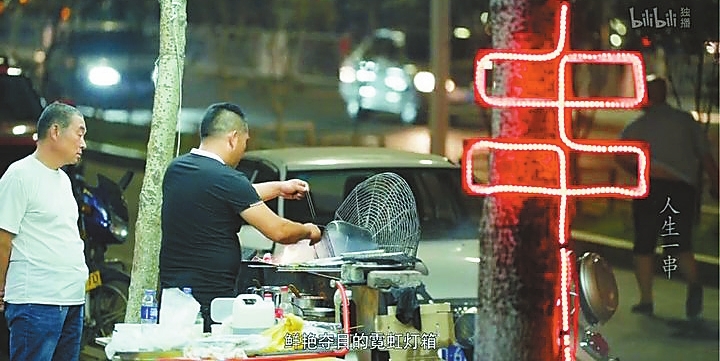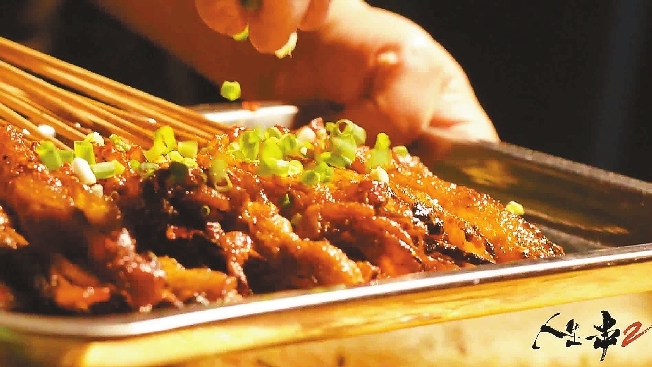


IT has been a while, but as the kebabs are still sizzling on the grills, the continuation of the story of chuan’ers, or Chinese barbecues, finally embarked on its long-awaited follow-up this June to satisfy the foodies’ screen time. Ornamented with silky-toned narrations and high-definition footage of food, the stories of this household street food still soften the beholder’s heart. The second season of “The Story of Chuan’er” had been streamed over 50 million times less than a month after its premiere, while receiving over 830,000 bullet comments on the streaming platform Bilibili and a rating of 8.6 out of 10 on the iMDb-like social media site Douban. Telling good stories in the bullet comment age The continuation has been well-received according to Bilibili standards, where the quality and popularity of uploads are largely measured by the bullet comments flying across the screen. However, Wang Hailong, chief producer of the documentary, stated that the more kudos the documentary has gained on the platform, the higher the benchmark will be set, for all the feedback is reflected instantly in the bullet comments of each frame. Wang and his crew were ready for the challenge. Chen Yingjie, chief director of the documentary, concluded that the stories they tell should be intriguing enough to keep the viewers in their seats. Although the documentary struck a chord among youngsters, Wang stated that they weren’t deliberately pandering to the youth’s tastes. “Youngsters are not likely to be moved by a still, close shot, or a single line of the documentary, but they may nod towards the emotions expressed as a whole, which echoes their thoughts towards truth, personal value and society,” he said. The folksiest way of filming Like the first season, the four-character title of each episode summarizes the features of chuan’er stalls from across the country. However, the titles were conceptualized in a humanistic and witty way instead of being merely categorized according to the raw materials. “We even thought of naming each episode after an animal. However, the idea was proved infeasible, because some animals, such as pigs, have too many edible parts to cover in the limited duration. Still, the food terminology should be explicit in the title as well as imply the embedded interpersonal relations,” said Zhang Yueming, a producer of the documentary. The crew stated that in order to document the folksiest side of chuan’ers, they chose ordinary stalls with low prices and, if possible, secluded locations instead of Michelin-starred restaurants in metropolises. The filming was also carried out in a low key manner, lest the owners and customers of the stalls feel uneasy. Xu Tianchun, videography director of the documentary, recalled his experience of filming a jam-packed barbecue stall in northern China. The audio was recorded by a microphone installed on a stand from outside a window above the sink, as all the space in the stall was occupied by customers and utensils. Writing while editing While a prewritten script is a must for the filming of most traditional documentaries, “The story of Chuan’er” had the copywriting finished along with the editing. Therefore, a scene like that of an absent-minded passer-by at Nanchang Railway Station is made more interesting when the narrator is speaking about an out-of-body experience while eating spicy food. After seeing footage of barbecue owners in the northwestern Chinese city of Lanzhou, a sense of rivers and lakes struck Chen and Zhang, who were also major copywriters for the documentary. They used expressions like “swordsmen from the Northwest” to create an aura of chivalry. Every city has a temperament If one compares the elements of a food documentary to a cake with 10 servings, seven out of the 10 servings should go to the food itself, while two go to the filming locations and one goes to the story, according to a popular filming norm. However, Chen stated that in the case of “The story of Chuan’er,” an extra serving should go to the locations to tell about the exclusive temperaments of the different cities. Quanzhou City of Fujian Province is a delicate city dotted with ancient mansions and restaurants serving home cooking. Here, chuan’ers are connected to small grills settled in backyards, and gentle talk between family members or friends fill the air instead of the smoky stalls suffused with the scent of alcohol in the north. The crew held that the story of chuan’ers in Quanzhou offers great exclusivity and a vivid sense of security. A story beyond chuan’ers The documentary not only unveils the highlights of most ordinary people, but also sheds light on the gems of ordinary street food beyond the chuan’ers themselves. A winter night spent with the crew by a pot of hot soup and a plate of stirred noodles gave Wang Hailong as much a sense of contentedness as the chuan’ers did. Frankly speaking, “The story of Chuan’er” is not only about a certain kind of household street food. It speaks about the instinctive need of human beings for food, warmth, and the courage to weather the headwinds of a mundane life. “Longing for warmth, groping for delicacies, yearning for comfort ... Those are all aspects of human nature. The documentary touches human nature and portrays a lifestyle that softens the beholders’ hearts,” said Wang. (Wang Haolan) | 
